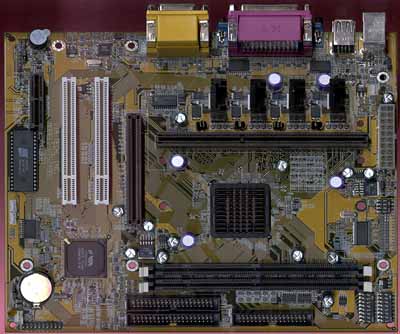VIA Apollo KX133 Athlon Chipset - Part 1
by Anand Lal Shimpi on February 7, 2000 11:51 PM EST- Posted in
- CPUs
VIA supplied us with one of their reference designs used by motherboard manufacturers as a guideline on how to properly implement the KX133 chipset. The board they supplied us with is their microATX reference board. This board isn’t publicly available, but don’t be surprised if you see other microATX KX133 motherboards popping up that look a lot like it.
The board is a four layer design which, upon finding it out, immediately triggered a light bulb over our heads in the lab. One of the biggest drawbacks of AMD’s Fester reference design with the 750 chipset was that it was a 6-layer motherboard. While 6-layer PCBs are generally better than 4-layer PCBs because they allow for greater insulation between the power and ground traces, they are also considerably more expensive. This was one of the reasons that companies like ABIT, who won’t manufacture a 6-layer motherboard for reasons of maintaining set profit margins (which are quite low in the motherboard industry), never made an Athlon motherboard. While it isn’t the only reason, you can expect many more motherboard manufacturers to come out with KX133 designs than they did with AMD 750 based designs simply because they can make 4-layer boards.
The 4-layer reference design does hold one key advantage for KX133 motherboards as a whole - they should be noticeably cheaper than their AMD 750 counterparts. Coupled with the highly integrated 686A South Bridge, KX133 solutions should be quite affordable. With a microATX reference design, you can expect to see some pretty cheap microATX KX133 boards pop up every now and then for use with AMD’s upcoming Spitfire chip, a low-cost Athlon with on-die L2 cache.
VIA does have a standard ATX reference board; we managed to take a look at one of those back at Fall Comdex ’99. The most noticeable feature of that reference design was that the board itself was quite large, much like the FIC SD-11. It is highly doubtful that many manufacturers will be following that design down to the last point simply because of the incredible size of the board, but don’t worry, not all KX133 boards will be microATX solutions.
The reference board did not provide us with any stability problems, but that doesn’t mean anything for the shipping KX133 solutions. As long as motherboard manufacturers follow VIA’s guidelines and their reference designs closely, KX133 motherboards shouldn’t have any problems, but as soon as they start cutting corners to save costs, this could change.
Right now, the physical hardware implementation of the KX133 chipset is complete on most motherboards that are scheduled to ship before the end of this quarter. Now, the main hurdle that has to be overcome is tweaking the BIOS for optimal performance and stability.
Unfortunately, most of the KX133 boards that were supposed to be ready by January have been delayed. AOpen’s KX133 solution has been delayed until late February or early March, and Tyan’s solution is still a few weeks away. EPoX will have one of the first shipping KX133 based solutions world-wide, and we will be taking a look at their solution shortly.
The EPoX design is done, the hardware is complete and the shipping revision of the motherboard is ready. The BIOS is the only limitation as they’re still working towards tweaking the BIOS to ensure maximum performance and stability.
Unlike the first Athlon boards based on the AMD 750 chipset, there will be quite a few KX133 based solutions on the market. This should anger Intel quite a bit since the one manufacturer they object to being on a motherboard more than AMD is VIA. VIA chipsets are in direct competition with Intel’s solutions (whereas AMD’s 750 wasn’t “directly” competing with Intel’s chipsets) and thus Intel will be using every trick in the book to try and get them out of the picture (including trying to stop VIA from exporting products to the US).











0 Comments
View All Comments